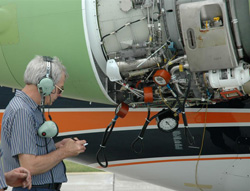Shane Heier, Engine Tech Rep

A qualified Duncan Aviation TFE731 technician performs gearbox pressure checks, as part of a 5-point incoming engine run.
Have you ever had an early morning smell of napalm in your pristine cabin? If so, the boss and other passengers are probably not impressed by the slimy synthetic smell. The blue tint in the air is probably a little disconcerting as well. Below are three steps to identifying the source and getting rid of the bad smell.
Step One: Identify the Offending Engine(s)
This offensive smell is caused by engine bleed air and the first step is to try and isolate which engine is contributing to the condition. Oftentimes, one engine is not always the answer as both engines may be contributing; but it often helps. Pilots need to take note of when the smell is at its worst: during the first start of the day; during take-off or at the top of descent? That type of information is useful.
Step Two: Gearbox Pressure Checks
Next, a qualified TFE731 technician needs to perform gearbox pressure checks. This will tell the technician where the fault area is located. It is either in the #l or #3 carbon seal area or in the #4 or #5 carbon seal area.
Step Three: Borescope Inspection
After the fault area is identified, a borescope inspection through the LP bleed port will, in many cases, demonstrate evidence of oil on the HP compressor impeller. Now, in order to repair the #4 and #5 carbon seals, the engine will need to undergo a compressor access. The #l and #3 carbon seals are field repairable and, in most cases, you can be back in the air in a couple of days.
After the new carbon seals are installed, it is not uncommon to see a slightly different oil pressure reading than observed previously. This is largely due to the combination of negative scavenge pump pressure in the fan gearbox that wasn’t there before, combined with positive pump pressure. This is something different than you are used to observing, but is not a cause for alarm. The engine oil pressure should still fall within normal tolerance levels; it just won’t be quite the same as before. You can find more detailed information on oil pressure changes, in the Honeywell Service Information Letter F731-83.
For help in troubleshooting and solving your maloderous cabin problems, contact any Duncan Aviation Engine Service Sales Rep or Rapid Response Engine Technicians.
Shane Heier is an Engine Tech Rep located at Duncan Aviation's Lincoln, NE, facility. He has traveled all over the world troubleshooting, educating and providing engine technical support to business aircraft operators. He specializes in Honeywell engines. Shane's aviation career began in 1991.


